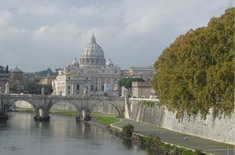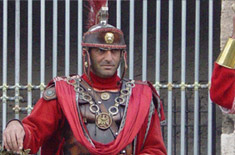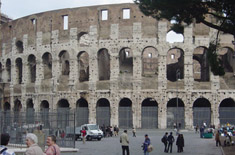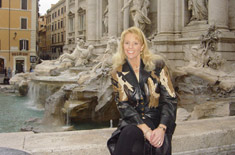Rome
Bonjiorno! Welcome to Rome, one of my favorite cities in all of Europe. There is so much to do here, you can never spend enough time. It’s “the eternal city!” Lord Byron called it “City of the Soul.” Well, whatever you call it, when you explore this amazing city, you’ll discover why Rome is not only the capital of Italy, but it was once the capital of the world.
Whether you’re interested in walking in the footsteps of the emperors, discovering the treasures of ancient Rome, or walking in the footsteps of the saints as you discover papal Rome, you’ll make incredible discoveries that will stay with you forever. Unlike other cities, the treasures of Rome will never be locked away in dusty museums, they’re on every street corner and around every curve of the road. Sprinkled everywhere for all to admire, the monuments and artwork of great civilizations are here to be openly seen and enjoyed.
Ancient Rome through the Rome of the new millennium, hundreds of years of history coexisting happily together: Medieval, Baroque, Renaissance, they’re all here! Courteously blending, in order not to be forgotten! Rome has so much for so many, and it’s all just waiting for you to discover!
The best place to start is where it all began, Palatino or the Palatine Hill. The ancients believed this was the home of Romulus, the mythical founder of Rome. You’ll remember the wolf babies and the 7 hills from your history class. From there, I say head over to see some more modern antiquities, the Pantheon and the Roman Forum. The Roman Forum was the center of life in ancient Rome, socially and politically. A sort of ancient downtown.

Once a swamp, then used as an ancient burial ground, the Forum became the center of Roman life in the 6th Century BC, when an Etruscan king drained the land and began establishing a cultural and political gathering place. It’s hard to believe that all of this was buried under 25 feet of dirt and debris until the 19th Century when excavations began. Today, the Forum reveals an amazing collection of ruined temples, civic buildings, arches and shops that, if you squint your eyes, convey the true essence of ancient Roman life.
The Pantheon is one of the most majestic and best-preserved monuments from ancient Rome. The present building rebuilt in 80 A. D., by Hadrian, stands upon the ruins of the previous temple, built by Agrippa about a hundred years earlier. One of the most interesting monuments is the Arch of Constantine. Marking the boundary between the Forum and the Coliseum, the arch was built in 315 A. D. in memory of Constantine’s victory against Maxentius. What makes the arch interesting is that it was built at a time when Rome was running out of money, so the builders pillaged other monuments and buildings for materials, statues and ornamentations. I guess the Romans invented recycling too!
Next door to the Forum is my personal favorite, the Coliseum. Opening for business about 80 AD, the coliseum has long been a controversial thorn in the side of Roman history. Wow! Actually being here is so special. You see it in books, but seeing it in person is even better. You can almost hear the roar of the crowd…and the lions! It’s famed architecture and bloody legacy continue to be a source of Roman pride, and, embarrassment. An arena of incredible size, the coliseum had 80 numbered entrances, which allowed over 50,000 spectators to enter and be seated within ten minutes. Wow! The wealthier and more powerful citizens sat on the lowest tier closest to the action while the peons sat in the nose bleed seats.
Speaking of blood, did you know that the moveable wooden floor of the coliseum was covered with sand to better soak up the blood? The blood sports were “corrupt versions of the Greek games” and were introduced to satisfy the Roman appetite for violence. Slaves, criminals, Christians and political agitators were pitted against each other, as well as, against wild animals imported from Africa, including lions. Glorified in the Oscar winning movie, “Gladiator” the coliseum was restored and reopened to celebrate the Holy Year of 2000.
Now, they say, when in Rome…What else do Romans like to do? You got it! Like me, the Romans like to SHOP! Shopping in Rome is no blood sport. While the pace and the prices may kill you, the reward is some of the finest fashion and flashiest finds in the free world! Before you start your shopping, do a little shopping for an exchange rate. Italy is on the Euro now, and while it’s always been expensive here, it just seems a little more expensive now. And, when you do your shopping for an exchange rate, don’t spend a lot of time on it. I mean, you don’t want to waste a lot of your time to save a couple of Euros. But when you do go to an exchange booth, make sure you count your change. For some reason, when they’re counting back that money, there’s a mistake, in their favor! Huh? Go figure!
I’m like a kid in a candy store – I want EVERYTHING! Prada! Gucci! Magli! Aw, but, be careful as they might be all closed! How, how can that be? They close half the afternoon for siesta and they are closed on holidays, so check the calendar and your wristwatch! You don’t want to miss out on the best designers, and being able to use your use credit cards plus tax free shipping, it all adds up to some of the best shopping on the continent. Indulge! Hey…it’s only money!
You know, people always ask me, where should I go in Rome? What should I do? Well, this is my little travel tip. The Piazza Novona, this is where I come in the middle of the day, especially for lunch. You have tons of gorgeous little outdoor cafes, you have your artists, you have your vendors, you have your pigeons and your buskers. And oh! You also have some very lovely fountains! One of the most beautiful and famous squares in Rome, the Piazza Novona is built on the site of the ancient Domitian Stadium. The fountains here are all masterpieces designed by the famous Baroque artists, Bernini, Borromini and Giacomo Della Porta.
In the center of the square is the Church of St. Agnes in Agony designed by Rainaldi and Borromini. The Piazza, one of the most frequented in Rome by tourists and locals alike, welcomes thousands of people every day with restaurants and nightclubs going strong late into the night. What I love about the cafes here is that there’re so many of them. You can walk along, look at the tables, read the menus. Just browse until you find one you like. Ah! Perfecto! Take one with a view!
So, where do the elite meet to eat and greet? Via Veneto, of course! Located just a few blocks away from the Spanish Steps, it’s been called the most prestigious street in Rome! It’s been a famous meeting place for the jet set for decades, and here’s where to find the luxury hotels and exclusive clubs that have been immortalized in films.
It is the allure of the glitterati that has enticed many filmmakers to come here. Take Federico Fellini, for example, he filmed several of his films here, including his best loved masterpiece “La Dolce Vita.” In English, that means: The sweet life! You’ll also remember Roman Holiday and 3 Coins in the Fountain top mention a few. Harry’s Bar was a favorite hangout for Fellini and his cronies and is still packing them in today.
How nice it must have been to live in an era and a place detached from ordinary life with an atmosphere of refined elegance that was both sparkling and frivolous. Well guess what. You can’t go back in time, but you can stay in a hotel that not only re-captures the essence of that whole scene but was originally right smack dab in the middle of it all. Called the “magnificent white palace on the Via Veneto,” the Westin Excelsior is of the world’s great classic hotels. It even has its own villa, the Villa La Cupola Suite, a 12,000 square foot 8 bedroom masterpiece on 2 floors. This one’s supposed to be the world’s most expensive hotel suite! Indulgence is part of a vacation, right?

Okay, enough lollygagging around! If it’s Tuesday it must be Rome and we have to GO GO GO! Not all of Rome’s monuments and historical sites are from ancient times. Italy under Mussolini remains a painful reminder to the Italians, but an interesting attraction for out-of- towners! The Victor Emmanuel monument was built in 1870 to celebrate the unification of Italy and dedicated to Italy’s first king. But the locals don’t like it and call it “the typewriter!” Hmmm. It does kind of look like one. Considered a gross monstrosity by most Italians, it’s also been called “The Wedding Cake.” It served as headquarters for Mussolini, and now houses the tomb of the Unknown Soldier and a museum.
Well you can’t visit Rome without throwing a coin into Trevi Fountain. The most famous fountain in Rome, made by Salvi in 1735, the Trevi Fountain is considered one of the most beautiful fountains in the world and is one of the most visited places in Rome. According to legend, if you toss a coin into the fountain you will one day return to Rome. So far it’s worked for me!
From Fellini films to fashion photo shoots, the beauty of Rome provides a natural backdrop for action and excitement, with a “photo op” around every corner! And on every balcony! You know, I’m a sucker for a great view. If I can find a restaurant that has good view, that’s it. I’ll stop right there! But I want to see more.
Wonder what to do with the kids in Rome? I’ve got it! Take them on a balloon flight! Connected to the ground at all times, you’re reeled in and out like a fish! But what a ride! And once you get a glimpse of this gorgeous balloon in the sky, you just have to get on it! Hang on! You can see St. Peters with its dome at the Vatican. Talk about a bird’s eye view of Rome! This is great! The kids love this, and adults will, too!
Now, for an adventure that’s more down to earth, you’ve got to explore the Appian Way. The Apian Way is the oldest road in Rome. And what I love is, it looks almost exactly as it did a couple of thousand of years ago. My favorite things out here are the cobble stones. If you look at the road, you’ll see stones that are original. You can tell the original stones because they’re the great big ones. The little, tiny ones are called St. Peters, those are new, if you can call them new. But then you’ll find a piece of marble, randomly placed to fill in a blank space. When they didn’t have stones, they just used things that were available.
You might see part of old marble column. You can see the grooves. Maybe it fell down and they didn’t want to use it anymore, so they used it in the road, instead. Waste not, want not, must’ve started right here on the road! If you think you got a feel for ancient Rome in the city, walking around the Coliseum, the Forum, and St. Peter’s, then try the Apian Way, for a genuine feeling of Ancient Rome in the time of the Caesars. You never know what you’re going to stumble across out here, whether you’re walking or driving, It’s like going on a treasure hunt! Hey, you most definitely will see an authentic chariot rut along the Appian Way.
One of the treasures I found on the Appian Way was a little stand by the side of the road with beautiful artwork. These pieces are all hand cast re-creations patterned after ancient archeological elements found throughout Rome. There are reproductions of statues and buildings that you can take home as souvenirs.
The Appian Way’s also known for its catacombs, and, what looks like villas or churches along the side of the road, are actually the entrances to the catacombs themselves. In ancient times, it was against the law to be buried within the city limits of Rome, so those who could afford it, came out to the country for their final resting place. It’s kinda creepy but very cool. It’s places like this where you can definitely see how religion defines the Italian culture.
Millions of pilgrims, tourists and curiosity seekers flock to the Vatican every year to see for themselves, why it is so special! The only way to get around the Vatican is to walk. You’re going to do a lot of walking. When you get tired, you can take a rest in the central piazza. About the size of Central Park, Vatican City is basically made up of four buildings or areas. The oldest building here is Castel Sant’Angelo. Built in 139 AD as a mausoleum for the emperor Hadrian, this windowless “pile of bricks” has served as a fortress, a prison, a papal residence in times of turbulence and is a museum of 16th century furnishings and frescoes today. Turning your eyes towards the square, even when crowded, you can find solace here, and in listening to the bells toll.To really get an idea of the role religion plays in all of Italy, you have to visit the Vatican and Vatican City. Created from lands donated to the Church in the 8th Century by Pepin the Short, Vatican City has served as the cultural and spiritual center of the world for centuries and is home to some of the most magnificent works of art ever created. With less than 1000 inhabitants, Vatican City is a sovereign state within Rome, with its own flag, even its own stamps. The Pope, who is the Head of State, is also the Supreme Head of the Universal Church and from this tiny little “city-state,” his influence radiates through the Roman Catholic Church throughout the world.

Construction began on St. Peter’s Square in 1656 under the supervision of the Baroque Master Bernini. It’s interesting that the site of Vatican City was originally an unhealthy bog known for its snakes and diseases until it was drained for the planting of the Imperial Gardens in the 1st Century. Under Caligula and Nero, the area was turned over to the circus for chariot races and executions. It is here that St. Peter who is widely recognized as the first pope was crucified, hence the name of the square.
Behind the square is the Vatican Museum, home of the Sistine Chapel. Too much to see in one visit, we’ll have to come back another day! Six-acres in size, accommodating 95,000 standing worshippers, St. Peter’s Basilica is, without a doubt, the largest, most impressive church on Earth. Its domed roof is also the tallest point in Rome as no building is allowed to exceed its height. To call St. Peter’s a masterpiece is an understatement. It’s the crowning achievement of almost every important Renaissance and Baroque architect including Michelangelo, Bernini and Raphael.
The vastness of the interior, the architectural splendor and the historical significance of this holy place result in a stirring symphony for your ears, your eyes, and your soul. This is the second St. Peter’s church to stand on this site. Only the bronze statue of St. Peter with its irresistible kissable toe remains from the original church.
The most famous work of sculpture on display here (behind bullet-proof glass I might add) is Michelangelo’s Pieta. Finished when the artist was only 25 years old, it is perhaps the most-beloved and inspiring sculpture ever created. The magnificent art and the majesty of the buildings are great but let’s face it, the real draw here is the Pope. He does live here after all!
Yes, you can see the Pope. Every Wednesday morning, the Pope does a general audience at 10:30. Now, tickets are free, but you have to apply for them in advance. Do that as soon as you know your dates, so you’re not disappointed. It’s outside in the square in good weather and inside in bad weather. There’s no seat assignment. The earlier you get here, the closer you get to the front.
The Aula Paola VI Auditorium where they hold the audience with the Pope in the winter time seats 7000 people and fills to capacity every week. You’re going to want to pare down and travel light, commando! Lot of crowds, lot of lines. You’ll have to go through metal detectors and you’re going to stand a lot, so keep it simple.
Each Wednesday at 10:30 AM, Pope John Paul II blesses the crowds who gather to catch a glimpse of him. In warmer weather, he is under a canopy in St. Peter’s square, but in colder months, he addresses the audience from inside this auditorium built just for this purpose. People come from all over the world for a chance to gaze upon the Holy See and to sing songs of praise and adoration. Many people are called upon to speak, bishops, nuns, cardinals and lay people alike but it is the pope the masses come to hear. Speaking a total of nine different languages his Holiness rarely disappoints.
There is a clear view of the stage and the Pope from every seat in the house. Be sure to bring rosaries and religious artifacts for the general blessing. There’s an announcement to hold up what you want blessed, and the Pope then blesses everyone and everything in the room. Makes a great gift for catholic friends! Some folks are fortunate enough to get a personal blessing from the Pope. You can get in line behind the VIP’s and if you’re willing to wait, he may stay long enough to see you! If you’re not one of the lucky ones, perhaps you’ll settle for taking home a little memorabilia!
The Vatican gets millions of tourists every year. Wherever you have tourists, you have souvenirs. Now, some of them here are tasteful and some of them are not! Whatever Vatican souvenirs you end up taking home, one thing for sure is, you’ll take home some pretty awesome memories and if you’re smart, some amazing photos as well! Rome is one of the more beautiful cities in Europe, and a drive through some of the ancient sites at night shows Rome in a whole new light. Almost magical, it’s worth taking the long way home! A few years ago, Rome refurbished hundreds of temples, churches, galleries and archaeological sites for the Jubilee year of 2000. So now, Rome is glorious and glittering, and can face the next 2000 years with a pretty face, and a hopeful eye to the future!

Ahh, Rome. It’s a beautiful city with an incredible history. The problem is, one visit is never enough, so I guess I’m just gonna have to come back. You wanna come? After all, you did throw a coin into the fountain!
